1. IONS PUSHED TO ONE SIDE OF THE STALK
3. BOL'S IN VERTICAL MOTION - THE LORENTZ FORCE
4. BOL'S IN VERTICAL MOTION - PART 2
5. THE SUPERBOL AND ALTERNATING CURRENTS
13. MAGNETIC DUST SUCKED IN AND SPRAYED OUT
Suppose the BoL exists of two equal circlecurrents, one above the other, but not touching anywhere.

 Fig. 5.1
Fig. 5.1
The Lorentz force will make both currents to attract each other. We suppose the currents are free floating in the air (a proposal how such a system can be made stable is given in chapter 10 and 11), and so they will approach each other until they finally merge into one circlecurrent of double strength. Let's see what happens when we reverse the direction of the second circlecurrent.

 Fig. 5.2
Fig. 5.2
The Lorentz force will now make them repel each other, will at least keep them separate. One expects the two circlecurrents to depart and to form two different BoL's. But let us first look at the magnetic field of this SuperBoL, as we call from now on such a configuration of two opposite circlecurrents above each other.
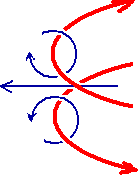
 Fig. 5.3
Fig. 5.3
The currents are of equal strength but opposite direction and would they merge, they would cancel each other out to zero current. And so would their magnetic fields that will nearly cancel each other out everywhere, except for the horizontal plane precisely between the two currents, where the magnetic fields add up to one field of nearly double strength. There exists a strong radial horizontal magnetic field and everywhere else nearly no field. A promissing property.
As shown at previous pages, the Ordinary BoL (from now on that is what we call a BoL with only one constant direct circlecurrent) has the disadvantage that the upper half counteracts the lower half, on its way up or down. Therefore, in case of vertical motion, only just above the ground a net force exists (Horizontal motion is treated in the next page). The Ordinary BoL therefore, as to speak, is especially designated for making flat pictures on the ground, where the stalk is not bent except just above the ground.
However, there are other possibilities. Suppose the (Ordinary) BoL is 1 feet above the soil between the crop and is below threshold velocity. At that moment it suddenly speeds upward passing threshold velocity. The part of the crop below the circlecurrent at the moment of launching will experience the influence of the lower half of the BoL only. While the part of the crop above the circlecurrent experiences first the influence of the upper half of the BoL followed by the influence of the lower half, which influences will tend to cancel each other out. No forces to expect then, except for the heat caused by the to and fro shaking of the ions in the stalk there. A similar effect occurs at the moment of sudden slowdown below threshold velocity. To keep it simple we don't regard these possibilities here any further.
The SuperBoL doesn't have that disadvantage. The effects of the solely active horizontal plane of the SuperBoL are depending on its speed and magnetic field strength only. No counteracting parts of its magnetic field. So the SuperBoL therefore seems to be more capable of making three-dimensional shapes.
A SuperBoL would be useful. But how to keep the two repelling circlecurrent together?
Maybe try to superimpose an identical alternating current to each of the circlecurrents. I mean in such a way that if the direct currents were absent, the remaining alternating currents would have same strength, phase and direction at any two points of the circlecurrents that lie directly above each other. What drives the circlecurrent, drives this alternating current too; it will be discussed at a later page.

 Fig. 5.4
Fig. 5.4
Two equal currents above one another attract each other. The alternating currents are changing all the time but at any moment they are equal. And so any pair of such points as shown in fig 5.4 would attract each other. This attraction counteracts the mutual repulsion of the direct currents and if they match, the circlecurrents will not recede nor approach each other but keep constant distance. But I can't judge under what conditions this could be stable, how much not yet involved properties play a role. Personally I don't have the necessary skills and mayby nobody has. Maybe the best thing here is a computer simulation, that when feeded with at least a little freedom for all possible properties, will in principle encompass all its possible developments. The details would e.g. also encompass the electricity conducting magnetic dust, see chapter 10 and further.
We need the alternating current to make the SuperBoL cohere. Without it it would decay. I don't know what currents are possible, but for the moment it is maybe better to make sure that the maximum of the alternating part doesn't exceed the constant strength of the direct part. Then a circlecurrent will always run in the same direction and only becoming stronger and weaker in counterphase with the other circlecurrent. When one circlecurrent is at its maximum the other is at its minimum and so will be their respective magnetic fields.
 Fig. 5.5
Fig. 5.5

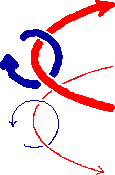

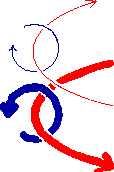

Fig 5.5 consists of 5 pictures. The 1st, 3rd and 5th are equal. There both currents are of equal but opposite strength and there will be the same strong radial magnetic field in the horizontal plane between them. The second and the fourth in fact simulate Ordinary BoL's of opposite current and magnetic field.
Mark that when one interchanges the two circlecurrents the magnetic field in the horizontal plane between them is inward then.
What is the resulting magnetic field of this SuperBoL? Take as plane of analysis the horizontal plane between the two circlecurrents, just in the middle of their mutual distance. The magnetic field (horizontal component only) is a succession of 1, 2, 3 and 4. It starts with 1:
1)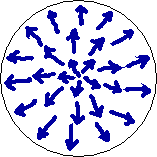 after which comes 2:
after which comes 2:
2) plus
plus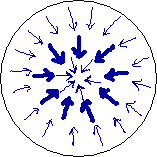 is something like
is something like
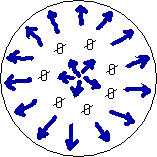
3) again, after which comes 4:
again, after which comes 4:
4) plus
plus is something like
is something like

and then the sequence starts over with 1), and so on.
So this is the SuperBoL: essentially one horizontal plane of strong horizontal magnetic field that fluctuate in strength with the frequency of the alternating current, maybe combined with some faint effects of the three dimensional magnetic field of an Ordinary Bol.
One possible way to drive the circlecurrent of the Ordinary BoL is by induction from the Earthstream, to be treated at page 8 and 9. The alternating part of the circlecurrent is induced and cannot be chosen freely. But the direct part of the circlecurrent can. It can run either direction and its strength is independent from the earthcurrent. If the SuperBoL is primed by the same mechanism an unanswered question is how any induction can make the upper circlecurrent to go in this direction and the lower circlecurrent in the opposite direction...
These alternating currents with their accompanying magnetic fields will certainly emit electromagnetic radiation. Amongst others, microwave (heat) radiation? The strong horizontal magnetic field of the SuperBoL, not counteracted by other parts of the field, can freely reach each part of the stalks, amongst them are the nodes.
In the next page we try to treat, try to say something about, horizontal motion of the BoL. There the vertical magnetic field component becomes important. Influences are more difficult to estimate at horizontal motion. By example, we have to consider what happens when a BoL on its path suddenly slows down below the threshold velocity (necessary for a growpulse to occur), moves a bit further and then strongly speeds up again. Should computer simulation be no luxury at this page, at the next it is compelled more than ever... but we don't have.
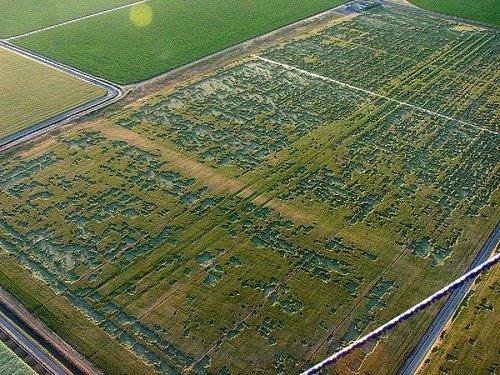
Random downed crop
I suppose